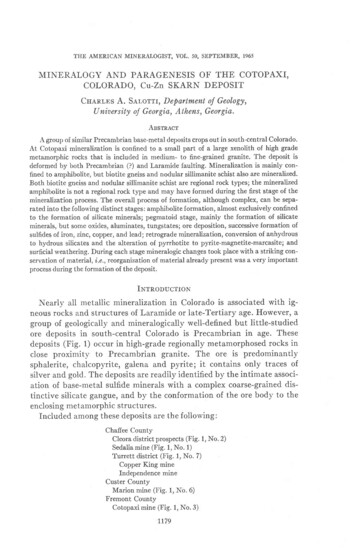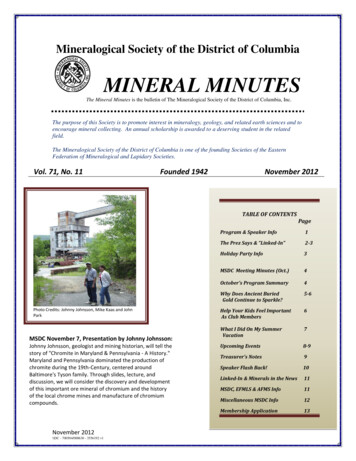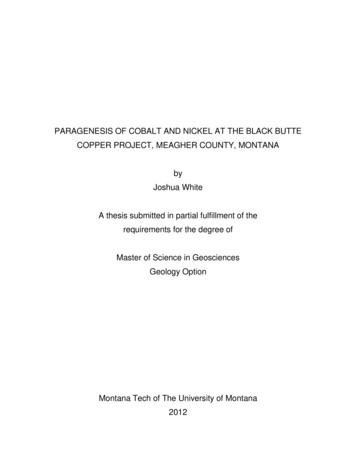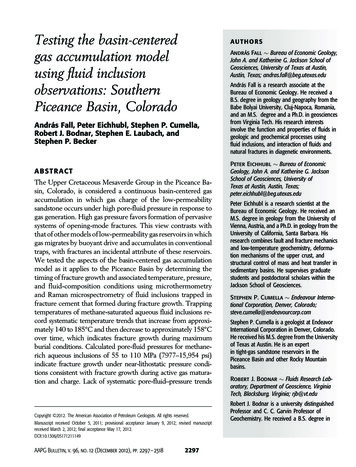
Transcription
THE AMERICANMINERALOGIST,VOL. 50, SEPTEMBER,1965MINERALOGY AND PARAGENESIS OF THE COTOPAXI,COLORADO, Ct-Zn SKARN DEPOSITCuenr.BsA. Sar-orrr,Departmentof crA group of similar Precambrian base-metal deposits crops out in south-central Colorado.At Cotopaxi mineralization is confined to a small part of a large xenolith of high grademetamorphic rocks that is included in medium- to fine-grained granite. The deposit isdeformed by both Precambrian (?) and Laramide faulting. Mineralization is mainly confined to amphibolite, but biotite gneiss and nodular sillimanite schist also are mineralized.Both biotite gneiss and nodular sillimanite schist are regional rock types; the mineralizedamphibolite is not a regional rock type and may have formed during the first stage of themineralization process. The overall process of formation, although complex, can be separated into the following distinct stages: amphibolite formation, almost exclusively confnedto the formation of silicate mineralsl pegmatoid stage, mainly the formation of silicateminerals, but some oxides, aluminates, tungstates; ore deposition, successive formation ofsulfides of iron, zinc, copper, and lead; retrograde mineralization, conversion of anhydrousto hydrous silicates and the alteration of pyrrhotite to pyrite-magnetite-marcasitel andsurficial weathering. During each stage mineralogic changes took place with a striking conservation of material, i.e., reorganizalion of material already present was a very importantprocess during the formation of the deposit.INrnonucrroNNearly all metallic mineralization in Colorado is associatedwith igneous rocks and structures of Laramide or late-Tertiary age. However, agroup of geologically and mineralogically well-defined but little-studiedore deposits in south-central Colorado is Precambrian in age. Thesedeposits (Fig. 1) occur in high-grade regionally metamorphosed rocks inclose proximity to Precambrian granite. The ore is predominantlysphalerite, chalcopyrite, galena and pyrite; it contains only traces ofsilver and gold. The deposits are readily identified by the intimate association of base-metal sulfi.deminerals with a complex coarse-graineddistinctive silicate gangue, and by the conformation of the ore body to theenclosingmetamorphic structures.Included among thesedepositsare the following:Chaffee CountyCleora district prospects (Fig. 1, No. 2)Sedaliamine (Fig. 1, No. 1)Turrett district (Fig. 1, No. 7)Copper King mineIndependence mineCuster CountyMarion mine (Fig. 1, No. 6)Fremont CountyCotopaxi mine (Fig. 1, No.3)rt79
1180CIIARLESA. SALOTTIIsabel mine (Fig. 1, No 5)Copper Boy mine (Fig. 1, No. 8)ParkCountvBetty(LoneChimney)mine(Irig.1,No.4)Of the propertieslisted aboveonly the Sedaliamine has had substantialproduction. Lindgren (1908) describedit as one of the few importantcopper mines in Colorado.A reconnaissanceof all the depositsindicated that the Cotopaxi mine isrepresentativeof this group, and a detailed investigation of this depositconstitutesthe basis of this paper. A study of the Cotopaxi deposit is ofFrc. 1. Index map of Coloradoshowingthe location of eight Precambrianmineraldeposits.value because it adds to the fragmentarv knowledge of Precambrianmineralization in Colorado. More importantly, due to the excellent exposures, small size and compact relations of the ore body, and the accessibility of much of the underground workings, such a study offers a rareopportunity for a detailed mineralogic and geologic investigation ofdeep-seated, high temperature mineralization.AcrNowr,BnGEMENTSMr. P. G. Owens, the present mine owner, allowed free inspection ofthe property and furnished all available maps and records concerning theprevious operation of the mine. Without the competent aid of my- colleague, Mr. Donald H. Poole, the plane table map of the mine and itsenvirons could not have been made. Drs. V. J. Hurst and L. D. Ramspottread the manuscript and made a number of helpful suggestions. The
COTOPAXI CU-ZN SK'4R17n6-tiE-.? ;I T i. E r9il:rery-!-:.7 VE UE.BIII( -'---\i:3 ;!:Itui'\Ix. /\E-.,i- - - ., 1-l* )iOQOboNffi-J- i. r, /,/
tt82CHARLES A. SALOTTIgibtic '6ii11st:- :i- rr:::Sillimonite9n.rss\.--.*O50IOO F.lFrc. 3. PIan of upper adit (elev. 6780) Cotopaxi Mine, Colorado.writer first visited the deposit with Dr. E. Wm. Heinrich in the summerof 1958 and has since examineddozensof Precambriancomplex pegmatites; lime silicate,tungsten-bearing"skarns"; and depositsof the Cotopaxi type in south-central Colorado. The National ScienceFoundationgenerouslysupported all phasesof the investigation.RrcroNar GBorocyThe Precambrian rocks of central Colorado consist principally of athick seriesof high-grade schists and gneisses(Idaho Springs formation)intruded by a successionof granite (Pikes Peak?) and closely relatedFrc. 4. Plan of lorver adit (elev 6750) Cotopaxi Mine, Colorado.
COTOPAXI CU-ZN isltlweekly Silicifi dSchislNodulor srllimonrlowS i h c r f i e dB i o l r t e G n e i s s( cP-sP slring rs,Section A-l5aMtno.olizod AmPhibolitaFoulto-r!-30 eiFrc. 5. Sections along upper adit, Cotopaxi Mine, Colorado.rocks. The metamorphic units near Cotopaxi occur as large' generallyconcordant, migmatized and. pegmatized xenoliths enclosed in granite(Salotti, 1960). Generally the granite shows good foliation parallel to thefoliation of the metamorphic xenoliths, with aligned biotite responsiblefor the structure. The general north trending parallelism of the foliationin the metamorphic rocks and the structure in the granite suggest thatthe area was a part of the north-striking Front Range anticlinoriumpostulated by Lovering and Goddard (1950).The granite is a monotonous, coarse-grained,locally porphyritic, redMognesionAciinoliieAnthophyllifeDiopsideG o r n e t( M g )PhlogopiteTourmoline( Locol)GohniteForsferite(rore)ClinohumitsGornet( Co)Scheelite(rore)BiotileGornet( Fe)Frc. 6. Generalized paragenetic diagram for amphibolitic pegmatoid.
1184CHARL]'SA, SALOTTIdish-pink, microcline-quartz-biotitetypical Pikes peak granitel however,severallocal distinctive variant faciescan be grouped as either stronglygneissoid,biotite-poor, allanite-bearing,or aplitic.The metamorphic rocks show complex folding in which foliation andmineralogicbanding apparently parallel the original bedding in most exposures.Included among the smail-scalestructures are those featurespeculiar to deepiy eroded crystalline complexes,i.e., ptygnatic folds,boudins, gradational contacts, augen, schlieren,localization of coarsePrimory Minerols( Secondory MinerolsAmphiboliteio Biotite-gornetEpidot6 MinerolsAlbitePyrrhotiteto Pyrife Mognetile cile?-?, ,-Surficiol ileHemotite Hydrouslron OxidesMolochiteStronlioniteFrc. 7. Paragenesisof the ore minerals,Cotopaxi, Colorado.grained qrartz andfor lime-silicaterock at the apexesof folds, and otherevidencesof plastic deformation.Late Laramide deformation in Fremont County has developedlarge,north trending block faults. The block faults are slightly displacedin thearea of the Cotopaxi mine by east-r,veststriking vertical faults. A largenumber of subsidiaryfaults and shearzonesaccompanythe major faults.The strike of the north-south faults in generalcoincideswith the northsouth trend of the Precambrianfoliation and fold axes.Pnrnor,ocyRock Descriptions.Indepositsof this type, the silicateand oxide mineralsgeneratedby metasomatismand reorganizationduring the formation of
COTOPAXI CU-ZN SK,4RT1185the ,,skarn-like" pegmatoid are generallymore indicative of the depositional environment than are the subsequentore minerals.A study of thegangueminerals has a further instructive advantage in that these speciesa r e * u c h l e s sl i k e l y t o r e f l e c tp o s t - d e p o s i t i o n ar el s p o n s e tso a c h a n g i n gthat occurred during mineralization are to be reconstructed'Not all rock types have shared,equally in the miner alization, but all areinvolved to some extent. The major rock units present in the Cotopaxiarea are:(1) biotite schist, (2) amphibolite-hornblende gneiss, (3) nodular sillimanite schist, (4)(2)biotite gneiss, and (5) lime-silicate rocks. Post-ore rock units include: (1) granite,pegmatite and (3) tonalite (Laramide ?).Biotite schist.l. GeneralDescripti.on:Biotite schist is not a common rock type in themine area. It is closely associatedwith sillimanite-bearingschist, generally as a thin border separating sillimanite schist and biotite gneiss.Theschistosity-is pronounced and the foliation conforms closely to the enciosingrocks.2. PetrograPhy:Biotite forms discontinuous trains of well oriented flakes. Quartz and oligoclase are theother essential minerals. The rock is uniformly fine-grained with all essential and accessoryminerals rarely greater than one millimeter in diameter. Accessory minerals include magnetite, sphene, garnet, microciine and apatite. Alteration products include sericite, hematite,Iimonite, leucoxene, and chlorite-magnetite.l{ odwlar sillimonite schist.l. GeneralDescr'iption:Nodular siliimanite schist occurs as separatedlensesand irregular massesinterlayered with biotite gneiss' amphibolitea "selvage" of biotiteand hornblende gneiss,and commonly possessesschist. Minerals visible on fresh surfaces are quartz, biotite, sillimaniteand muscovite. There is a marked tendency for sillimanite, minor quattzand later muscovite to be concentrated into ellipsoidal nodules which areflattened parallel to the foliation and range in size from 2 millimeters to 4centimeters. Biotite and quartz are the essential matrix minerals. Thecontrast of the speckled dark gray matrix surrounding the gray-whitenodules imparts a distinct augen texture to the coarserfacies of the rock.The rock has a singular weathering pattern; sillimanite-rich nodules pro-
I 186CHARLES A, SALOTTItrude above the weathered surf aceand impart a pseudoconglomeraticappearanceto the rock (Fig. 8A).2. Petrography:Riotite is principally responsiblefor the schistosetexture. Sillimanite generally liesparallel to biotite and contributesto the foliation. However,wheresillimaniteis presentasTe,nr,r 1. Moons ol Rrpnnsrxrerrl'r umnlrnnr,rzBo Rocrs Nnen rxp cororexrMrNn, Fnruoxr CouNrv, niteEpidote GroupOther Accessories(3)28.75079. 7 (Ab65)26.8(Abso)10.5(Abu)32.21 6 .54.24 2. 07.91 1. 5t a.\(s)(6)26.0 (Ab75)28.2 (Ab8e)5 6 .11 2. 2tr47 9.9100.1Tonalite.Amphibolite.Biotite gneiss.Nodular sillimanite schist.Biotite schist.Fine-grained granite.ciusters and knots, it commonly transacts the schistosity. The matrix is normally finegrained and consists of qtartz interlocking with oriented biotite. Essential minerals arequartz, biotite, sillimanite, and muscovite. Accessory minerals generally average less thantwo per cent of the rock and include zircon, garnet, microcline, magnetite, and apatite.Clinozoisite, sericite, leucoxene, albite, hematite and limonite are alteration products.Amphibolite and,hornblendegneiss.l. General Des*iption: Diverse types of amphibole-bearing rocks arewidespreadwithin the cotopaxi area. They occur as scattered,generallylensoidbodiesof irregular extent that intergradewith one another or withbiotite-bearing rocks, lime-silicate rocks and migmatite. Both field relations and petrographic evidence indicate that most amphibole-bearing
COTOPAXI CU-ZN SK,4R/[/r187rocks are likely metasediments,but some appear to represent metamorphosedintrusive basic igneousrocks. Two general types are recognizable. The distinction is petrographic: with essential qtattz ( 57) therock is hornblende gneiss;without, it is amphibolite. Most hornblendegneissis more foliated than amphibolite, but not conspicuouslyso, anddoesnot possesswell developedmineralogic banding.2. PetrograPhy:In general, hornblende gneiss has a granoblastic texture in which hornblende is onlyfor mostslightly elongate. A crude planar orientation of hornblende crystals is responsibleonly -gneissic texture. Individualweak lineation.moreEssential minerals are hornblende, plagioclase, and subordinate qlJartz. one orgreenrock composed of about equal parts of clinozoisite, diopside and hornblende (z: lightto blue-gieen). The texture is fine-grained and distinctly granoblastic. MicroscopicallyThesethere is no evidence whatsoever that clinozoisite formed at the expenseof plagioclase-minerals of the two rocks are identical'Biotite gneiss.l. GeneralDescription:Biotite gneissconstitutesthe bulk of the metamorphic rocks in the immediate vicinity of the mine' It is typicaliy apoorly-banded pink to gray quartzo-feldspathic rock in which biotiteiather than hornblende is the ferromagnesionmineral. Ptygmatic dikeletsof aplite to pegmatite are locally abundant. A characteristic feature ofthe gneiss is local concentrations of biotite deficient haloes surroundingmagnetite euhedra (Fig. 88).magnetite areQuartr, microcline, oligoclase,biotite and allyminerals.essential
1188CIIARLDS A. SALOTTIiI31E(}tt,Frc. 8A) Nodular silimanite schist is u'hich protuberant nodules of resistant sillimanite-quartzproduce a distinctive pseudo conglomeratic appearance to the rveatheredoutcroD.Henthorn Gulch, Cotopaxi mine area, Colorado.B) Poorly banded biotite gneiss rvith quartz-feldspar envelopes containing single grainsofmagnetite. Henthorn Gulch, Cotopaxi mine area,(-) Fibrolitic sillimanite nodule showing the finely Colorado.felted texture of individual s.vr,.orls.Abiotite-poor (b) quartz (q) halo surrounds the sillimanite nodure. photomicrographofrock.shown in A. Plane polarized light. Henthorn Gulch, cotopaxi mine area,cotoiaao.D) Biotite gneiss in which poorly defined biotite (b) layers alternate with quartz (q) and
COTOPAXI CU.ZN SK'4ft,ry1189muscovite,garnet, sphene,and zircon. Sericite,hematite, limonite, andrare chloritesoccur as alteration minerals'2. Petrography:un{er the microscope, biotite gneiss exhibits many of the textural features common tobiotite schist. The fabric is granular, composed of quartz and feldspar with dispersed subparallel biotite responsiblefor the foliation. Quartz generally exceeds50 per cent of the rockand is commonly fractured and granulated at grain edges. The plagioclase is stronglysericitized oligoclase. Magnetite is commonly an essential mineral, rare in the matrix, butoccurring as euhedral porphyroblasts surrounded by a roughll' circular felsic envelope inwhich biotite is conspicuously absent. Garnet is the commonest accessor)'mineral, butrarely exceeds 1 per cent of the rock. Sphene and magnetite are closely associated. Zirconis not as plentiful as in sillimanite schist, and muscovite is rareLime-silicote rocks. Lime-silicate rocks are scarce in the vicinity of theCotopaxi mine. Two types can be distinguishedon the basis of whethercalcite is an essentialor an accessorymineral. The common variety,which contains onll' accessorycalcite, is non-foiiated, fine- to mediumgrained, dull green to iight waxy brown, and is confinedto the crestsofsmail, tight, nearlv isoclinalfolds in biotite gneiss.Uncler the microscope lime-siiicate rock with accessory calcite is seen to consist of greendiopside, epidote, zoisite, quartz,garnet and scapolite (dipyre) Calcite, sphene, clinozoisiteand rare apatite are accessory minerals. Sericite, lr'hich replaces scapolite, is the only alteration product. Epidote, zoisite and scapolite are poikiloblastic and enclosegranular diopsideancl less commonly garnet Quartz and minor calcite fi1Iinterstices between grains.Lime-silicate rocks rvith essential calcite are associated with amphibolite and formsmall lensoid bodies commonly gradational to normal amphibolite. Essential minerals arescapolite, calcite, epidote, qttartz and chlorite. Accessory minerals include serpentine,sphene and rare chalcopyrite and tourmaline.If lime-silicaterocks were included in the minererlizedzone, they havebeen so altered that their original characteris no longer identifi.able.Inany event, they would constitute only a smail part of the mineralizedvolume of rock.SrnucrunBThe Cotopaxi mine is located in a small gulch one-halfmile northwestof the bridge at Cotopaxi in the southwest quarter' Sec. 25, T'48N',R.11E., Fremont Countv, Colorado. It lies in the northeast corner of aone and one-half by two mile xenolith of intermediate to high-gradefeldspar (microcline (m) and oligoclase (o) layers. Oligoclase shorvs sericitization alongalternate albite twins. Magnetite (opaque) and accessory sphene (s) and small almandite (d) euhedra complete the field Plane polarized light. cotopaxi mine area, colorado.
1190CHARLESA SALOTTImetamorphic rocks enclosedin granite. Near the mine the granite is afine-grained, almost aplitic, reddish rock. The ore is erratically distributed in a sulfide-impregnatedamphibolitic rock that is generally confined between hanging wall sillimanite schist and footwall biotite gneiss.The footwall biotite gneiss is more or less mineralized and locally intensely silicified for some distance below the contact; the hanging wallsillimanite schist is relatively unmineralized. The strike of the metamorphic foliation is quite variable, but dominantly it is N-S to NW-SEand dips 35-45 E.The ore body is bounded by two NE-SW striking faults and by aNw-sE striking crossfault, all of which are essentially vertical. A number of steeply dipping auxiliary-faults, striking N-S, EW complicate themajor fauit pattern (Fig. 2). The age of the faulting is uncertain. However, mineralogic and structural evidenceindicate two periods of faulting.The NE-SW striking faults are likely Precambrian in age and appearcontemporary with the waning phase of mineralization; all other faultsprobably are Laramide in age.The easternmostof the Precambrian (?) faults is representedby a finegrained reddish rock that varies from 5 to 15 feet in wid.th and showsstrong evidence of shear flow. under the microscope the rock consistsalmost entirely of chessboardalbite and very subordinate chlorite. wherebest exposedthis shear zone representscompletely altered biotite gneiss.The westernmost of the Precambrian (?) fault zones is composed ofsheared biotite gneiss and amphibolite. Biotite gneiss has been chloritized, partly albitized, and silicified; amphibolite has been entirelychloritized. The alteration was highly pervasive, and many original textures remain some distance from the shear zones. The precambrian (?)fault zones are barren of ore minerals or gossanmaterial.The faults assigneda Laramide age difier significantly from the precambrian (?) faults in that they are tight narrow faults. The entire faultzone is rarely over three inches in width. They are characterizedby relatively small displacements, and intensely slickensided.and fracturedwalls. Retrograde mineralogical alteration is absent; only minor secondary thin films of calcite,gypsum and iron-manganesestaining are present.The metamorphic foliation surrounding the mine shows the effects ofplastic deformation, but little evidence of local folding. ore control bypre-existing fold structures, if any, has been obscured by post-ore faulting. The sulfide-impregnated amphibolite layer was undoubtedly chemically reactive to ore deposition. However, it is possible that the biotitegneiss-amphibolite-sillimaniteschist sequenceis not an original order. rtmay be that a bedding surfaceseparatingincompetent,sillimanite schistfrom more competent biotite gneiss acted as an incipient fracture and
COTOPAXICU-ZNSK,4RIT1191localized first Mg-Ca-Fe-Al silicates, which in turn were replaced bysulfide minerals. The coarse pegmatoid appears to have been a localdevelopmentconfinedto that part of the depositnow nearestthe surfaceand occupiedby the glory hole. More or lesssurroundingthe amphibolitebiotite locally rich in euhedralis an alteration enveiopeof coarse-grainedgarnet. It is especiallywell developedalong the hanging wall contact' andcommonly forms a selvage on late transecting sulfide veinlets in theamphibolite.Small isolatedpods of granite occur within the mineralizedarea. Theyare barren of sulfide minerals and lithologically similar to the fine-grainedgranite that bordersthe xenolith. A large simple unzonedquartz-feldsparpegmatite south of the deposit transectsthe metamorphic foliation; thispegmatite is likewisebarren. A small body of milky quartz standsin erosional relief immediately west of the ore outcrop. It contains scatteredeuhedral gahnite and rare boxworks suggestiveof original ore minerals.This quartz pod is cut b--vthe westernmostof the Precambrian(?) faults.A thin tabular tonalite dike lies along one of the younger Laramidefaults. The dike has chilled marqins and is unmineralized.OnB DnposrrSilicate and.or'id,epegmatoid.Within the pegmatoid are unaltered relictsof country rock. These relicts maintain their stratigraphic positions andmineralogicallyand texturally gradeinto pegmatoid.The rock types formed during the silicate and oxide pegmatoid phaseand to a lesserextent mineralogically,closelyreflect the comchemicall,'-,positions of the metamorphic parent rocks. This strongly suggeststhatreorganizationof the alreadyexistingrocks was a pron.rinentfactor in thegenesisof the pegmatoid. Unquestionably the formation of the pegmatoid was more than an example of paramorphism. However, only zinc(gahnite) and possibll'fluorine (clinohumite) need to have been added insignificant quantities. Boron (tourmaline), tungsten (scheelite), andmoll-bdenum (nolybdenite), although likely additions, are present insuch minor amounts that the possibility of their generation through aconcentrationof original material releasedduring reorganizationcannotbe precluded.Particularlf if one considersthat lime-silicaterocks mayhave been among the pre-mineralizedrocks. Cotopaxi clinohumite contains 2 per cent fluorine whereasmineralogicallytypical unmineralizedamphibolite near the mine contains0.5 per cent fluorine (Table 2). If thesource material of the actinolite-anthophyllitemine rock were such anamphibolite, the relatively smali volume of clinohumite to that ofamphibole requires that only a small part of the fluorine in the original
r192CHARLES A. SALOTTITerr,r 2. Crrnurcer.Arnr,vsns ol Alpnrror,rrr, Acrrxourr, Glrrwrru, el'o Cr,rxoEUMTTECoropaxr Mwn, 8l.o22.468.090.466 569.822.721. 3 1.606.2524.656.19o.201.860.170.04CDGahnite60.760 .5 84.5610.3323.77Clinohumite3 7. 0o.26r2.88.7r,21. 8 rMajor0.3211.4 (total)2.099.3rA. * Appreciable amounts. C. O. Ingemalls, Analyst. Alkali determinations, E. Martinec. P2O5,M. Bailey. Sample obtained approximately one-quarter milefrom Cotopaxi Mine, Colorado.B. Law and Company, Analyst. Cotopaxi Mine.C. Keller, analyst in Genth. Cotopaxi Mine.D. C. O. Ingemalls Analyst. 1. Spectrographic value courtesy of N. Suhr. 2. Totaliron calculated to FezOe.Cotopaxi Mine.amphibolite would need to have been released during reorganization toaccount for the formation of clinohumite.l. Recryslallized,Biotite Gneiss: Pegmatoid derived from biotite gneissis not conspicuously developed. It is difficult to distinguish the coarsegrained alteration of the more aluminous biotite gneiss from pegmatoidformed from low-alumina sillimanite schist. Most glassy massive qrtartzwas once biotite gneiss.The transition from biotite gneissthrough sugarygranular quartz largely leached of feldspar and mica, to massive glassyqlJartz speckled with minute bubbles, shreds of weakiy pleochroicamphibole, epidote, garnet, pale biotite, fluorite, rhombohedrat carbonate, rare tourmaline and sulfide minerals, is clearly evident in manysubsurfaceexposures.The alteration of biotite during the transition from
COTOPAXI CU-ZN SKARN1t93biotite gneiss to glassy quartz is readily traced. The biotite was firstbleached 10 that the pleochroism is sharply reduced and the optical indices generally are lower. With further alteration the biotite flakesdevelop ragged edgesuntil only shreds and bits remain. Presumably thealteration of the optical properties indicate a decreasein iron.The minerals are distributed in several closely associatedgroups. Biotite books up to 2 centimeters in diameter, euhedral molybdenite up to 1centimeter, rare coarsely crystalline albite 5-10 cm, and garnet in massesof interfering subhedronsless than 0.5 mm occur as small concentrationsin sugary quartz. Euhedral gahnite, pinitized cordierite and quartz concentrations are relatively common. Microcline remnants are found onlyin weakly silicified rock and here they are commonly corroded andembayed by quartz.2. Reorganized,Sillimanite Schi,st: Within the pegmatoid, sillimaniteschist has been thoroughly recrystallized. Much of the massive gahniteclearly replaces sillimanite (Fig. 9B) in altered sillimanite schist.Quartz-gahnite-cordierite with minor pale biotite is a relatively common rock type. Undoubtedly the high alumina content of the parent rockfavored this association. Microcline, commonly the variety amazonite,in anhedral crystals up to one and one-half inches replaces sillimanitenodes in nodular sillimanite schist. The texture of the original rock ispreserved and many microcline crystals still retain sillimanite cores.Whether microclinization preceded, was contemporaneous with, orfollowed the pegmatoid stage is indeterminate. The microclinized sillimanite schist was found only as dump samples.This part of the dump contains only unmineralized country rock, and for this reason it appearslikely that microclinization may have occurred only at the fringes of thepegmatoid development.Garnet is poorly developed in altered sillimanite rocksl here it occursas small ((0.5 mm) widely scattered anhedra generally in associationwith biotite clusters. Zircon shows no increase in grain size and is stillrestricted to the centers of pleochroic haloes in biotite. Nests of "sunburst" tourmaline are Iocally developed,but are not nearly as prominentas they are in biotite gneisspegmatoid.3. Amphibolite: Pegmatoid texture is best developed in rocks of amphibolitic composition. The dominant rock type is an actinolite matrixwith large (10 cm) slender anthophyllite laths as phenocrysts. Gahnite,clinohumite, phlogopite, and rarely forsterite are present in trace tomajor amounts. Diopside is rare, but isolated coarsely-twinned crystalsweighing up to 25 pounds are present in a relatively fine-grained actinolite matrix.Actinolite and anthophyllite appear to be essentially contemporane-
ttg4CHARLES A. SALOTTIT! lr lil,l;LFrc.9.A) Corroded but unaltered gahnite (g) surrounded by chalcopyrite (cp). Plane reflectedlight. Cotopaxi mine, Fremont County, ColoradoB ) Gahnite (dark gray) replacing sillimanite (light gray) inquartz matrix. Altered nodularc)sillimanite gneiss. Plane polarized iight, Cotopaxi mine, Fremont County, Colorado.Gahnite (g) replacing actinolite (ac) along the cleavage and in turn being replaced bygalena (opaque). The paragenetic relation of the small subhedral apatite (ap) is in-
COTOPAXICU-ZN SK,4RI /1195ous;minor high-magnesiumgarnet and phlogopiteare generallylater butin part overlap actinolite-anthophyilite.Gahnite is earlier than clinohumite, which commonly transectsit, but later than the previously mentioned silicates.Most gahnite is massive to subhedral,although a number of smzrllerspecimens((3 cm) show octahedralfaces.Some gahnite exists as smallsubhedronsin a glassycluarLzmatrix. The two phasesare sharply separated and the gahnite is commonlv unaltered. Cotopaxi gahnite is amagnesianvarietv, however, the substitution of consideralilezinc formagnesiummust have extendedthe stabilitv field of the spinel to aliowit to coexistwith quartz at elevatedtemperatures-andpressures.Forsterite and clinohumite show some evidence of simultaneouscrystallization,but m.ostclinohumite has replacedforsterite. Scheeliteisassociatedwith, and commonly surrounds; small, euhedral, lime-richgarnet. A coarse-texturedgarnet-biotite border separatesnmphiboliteand hanging wall sillimanite schist.It is particularll, well developednearthe structurally higher part of the amphibolite and "mantles" the orebody. Here it is severalfeet thick and most of the biotite is altered tochlorite-the garnet is entirely unaltered. Petrographic and field evidence indicate that the garnet-biotite selvage has formed through ahydrothermal alteration of the actinolite amphibolite.Figure 6 is a generalizedparagenesisof the reorganizedamphibolite.Ore Minerals.l. GeneralStatement:Unquestionabiythe developmentof the ore species is a part of the total mineralization sequence,however, r,vith theexceptionof scheeliteand possiblyminor molybdenite,they appear to bedistinctly later than the mineralsof the pegmatoidstage.The bulk of theore mineralsare intimately combinedwith amphibolite. Considerableoremineralizationis Iocated as irregular grains and euhedrain silicifiedbiotite gneiss;a minor amount occurs as late irregular, attenuated veinletswith an accessorygangue oI quartz, sideritic to calcitic carbonate,rndrare fluorite and apatite. 'Ihese veinlets transect all rock t1.pesincludingthose previously mineralized. The ore mineralogy and par:rgenesiszrrerelatively simple, particularly when comparedto the oxidesand silicatesdeterminate. Mineralized amphibolite Plane reflected light, Cotopaxi mine, Fremontmine, Fremont County, Colorado.D) Gahnite (g) and gaiena (opaque) replacing actinolite (ac). Galena is much more
At Cotopaxi mineralization is confined to a small part of a large xenolith of high grade metamorphic rocks that is included in medium- to fine-grained granite. The deposit is deformed by both Precambrian (?) and Laramide faulting. Mineralization is mainly con- fined to amphibolite, but biotite gneiss and nodular sillimanite schist also are .










